The best dash cam
A complete guide to the best picks and how to use them.
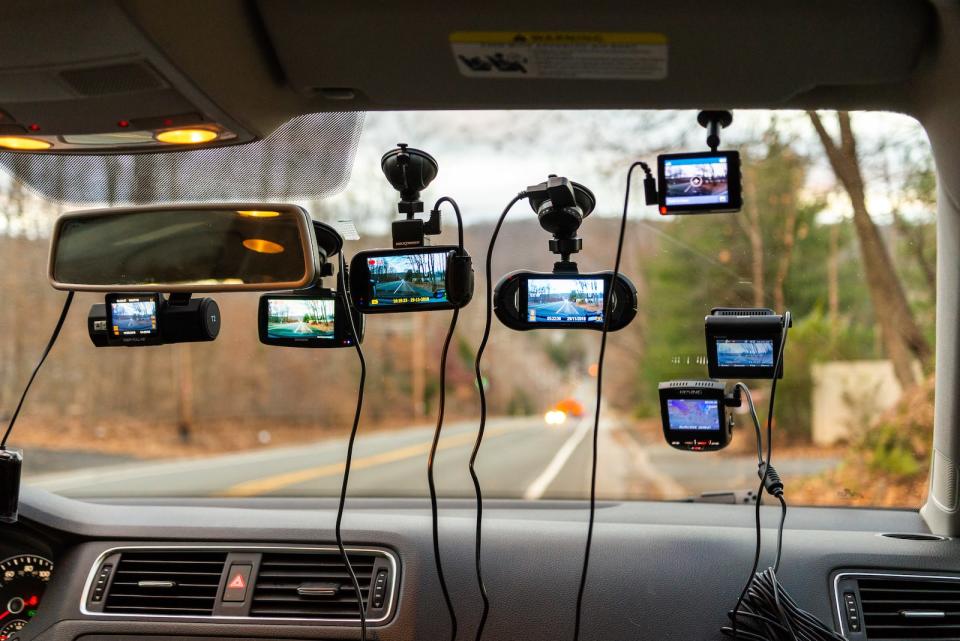
By Rik Paul, Molly K. McLaughlin
This post was done in partnership with Wirecutter. When readers choose to buy Wirecutter's independently chosen editorial picks, Wirecutter and Engadget may earn affiliate commission. Read the full dash cam guide here.
After researching about 200 dash cams and testing 30, we've found that the Garmin Dash Cam 55 is the dash cam we'd want on the windshield in case something crazy happens when we're out for a drive. This camera produces crisp, detailed video day or night, and its compact body sits securely in a magnetic mount that's among the simplest to set up and use daily.
The Garmin Dash Cam 55 records at a 1440p resolution, delivering better-quality video than most of the models we've tested, with sharp enough resolution to clearly read license plates and see other details in lighting conditions that other cameras struggled with. At only 2¼ by 1½ inches, the Garmin takes up less room on the windshield than most, and its small magnetic mount makes the camera easy to adjust, attach, or remove. You can perform basic functions through voice commands—a rare feature that helps make up for some awkward physical controls. It also has details common to higher-end units, like an integrated GPS receiver, Wi-Fi for connecting to a compatible smartphone app, and some handy driver assistance functions.
On performance, the Nextbase 512GW and Nextbase 612GW 4K are actually better dash cams than the Garmin 55—but this brand, popular in the UK and new to the US market, has been available inconsistently so far. If you can find either of these Nextbase models, you'll get the best image quality—as well as one of the best mounts and smartphone apps—of any dash cams we tested. A few details differentiate this pair: the 512GW records at 1440p resolution, has touch-sensitive buttons, and a plastic body; the 612GW records at a crisper 2160p (4K) and has both an easier-to-use touchscreen and a sturdier aluminum body. You can also connect an optional rear camera to the 512GW.
With its 1296p resolution, the Papago GoSafe 550's image quality is better than many models we've tested (although not as sharp as our top pick or runner-up). It has a bright 2.7-inch display, its mount provides a wide range of adjustment, and its controls are reasonably easy to use. Unlike our above picks, though, the 550 doesn't have a GPS receiver, Wi-Fi, or a compatible smartphone app—but that's the compromise you make for this camera's consistently lower price.
If you want to record incidents behind your vehicle (as well as in front), we recommend the dual-cam Papago GoSafe S810. Its front camera is surprisingly sharp for a 1080p model, allowing us to read the license plates on parked and some passing cars at lower speeds. It also provides good color and contrast and decent dynamic range at night. As with other dual-cam models, the rear camera is weaker, with a duller image, less sharpness, and more contrast.
If you want to record the interior of your car as you drive, we recommend the Vantrue OnDash N2 Pro, which has a camera to record the view in front of the car and another one facing the interior—handy for ride-for-hire drivers who want to document their passengers. The front camera—recording in 1080p resolution—provides good overall image quality, although it's not as sharp as our single-cam picks. And the rear camera shows passengers more clearly than similar competitors, especially in total darkness.
The Owl Car Cam is the best dash cam we've tested for monitoring your vehicle around the clock, including when parked. It has the usual front-facing camera and a second one for the vehicle's interior to document impacts from other cars as well as break-ins. If something happens, you get an alert on your phone, and the camera automatically records and uploads video, which you can view on the app (or watch live at any time). The Owl Car Cam is much more expensive than our other picks, though, and, while you get a year of free access to the company's 4G LTE service (needed for the remote access features), it costs around $10 per month after that.
Why you should trust us
Rik Paul, who conducted our latest tests, is Wirecutter's autos editor and was previously the automotive editor for Consumer Reports and the senior feature editor for Motor Trend. He has been testing and writing about automotive electronics and accessories for the past 25 years. To get the legal perspective on dash cams, he interviewed Ben Schwartz, a personal injury attorney and managing partner of Schwartz & Schwartz.
Molly McLaughlin, who wrote the previous update for this guide, has written about consumer electronics and software for PC Magazine, Lifewire, DealNews, and many others, and was a senior editor at ConsumerSearch, a reviews website.
Who should get this
If your routine drive ever turns into a life-altering event, you might appreciate having a dash cam to show what happened. This continuously recording, windshield-mounted device can document an accident you're involved in and provide you with evidence to share with a lawyer, insurance company, or law enforcement, proving something was not your fault (ideally) rather than hoping everyone takes your word for it.
Case in point: A Wirecutter staffer was able to use his dash-cam footage to prove that he wasn't at fault after being rear-ended in a parking garage. Although the forward-facing camera couldn't record the vehicle in back actually striking his car, he said "it showed that I was driving appropriately and captured the sound, jolt from impact, and mine and my girlfriend's reactions."
In addition, a dash cam can be useful for helping other drivers who need objective eyewitness evidence following a crash, hit-and-run, or road-rage incident to help them present their case or identify a vehicle. It can be used to record unsafe roadway conditions or monitor the driving habits of someone else such as a young, inexperienced driver or a aging senior (with their consent, of course). And it can come in handy if you want to capture and share a funny scene, memorable trip moment, beautiful vista, or unusual happenings—like streaking meteors.

"There are thousands of people who are injured and killed every year by hit-and-run drivers," said Ben Schwartz, a personal-injury attorney we interviewed. "If those hit-and-run victims had a dashcam in their car, maybe the video would record the tag number of the vehicle that hit them, and then that would lead police to the bad guys."
But there are potential disadvantages, Schwartz notes. "Not only will a dash cam document other people's mistakes, but it's going to document yours." Whether or not you think you're at fault, Schwartz says, you should first show the footage to your lawyer. "Let the attorney determine whether the footage is favorable or not favorable to [your] case, and let the attorney advise you on what to do with the footage."
Last, some practical considerations. Read how to set up a dash cam and start planning how you'll connect a dash cam in your own car (and ensure you have a convenient enough power supply) before deciding you're sure you want one. Almost all dash cams record video on a removable microSD card, and many don't include one, so this could be a separate purchase. A 64 GB microSD card (like the one we recommend) costs about $20, as of the time of writing. To be extra thorough, double-check to confirm you can legally mount a dash cam on your windshield where you live, and learn your state's rules for recording audio conversations.
How we picked
We spent hours researching the specs and features of about 200 dash cams and read reviews from PCMag, Autoblog, TechRadar, Digital Trends, BlackBoxMyCar, and T3 (many of which were thin on hands-on experience). We read customer reviews, perused some driving laws and insurance claims, and watched hours of people's dash cam footage.
Most dash cams have built-in G-sensors (or accelerometers) that detect an impact and automatically save the footage of the incident, and many also have a video-lock to manually save footage. You can review footage either on the unit's display, a smartphone app, or on any device that can read the camera's removable microSD card. Dash cams can record audio, and most models let you capture a still photo.
Those standard features aside, we also looked for:
The most important considerations
Image quality: A dash cam's video has to be sharp and distinct enough that you, a lawyer, your insurance company, or a member of law enforcement can read license plates and see other details clearly in light or dark conditions.
Controls: We wanted clearly labeled, easily reachable controls (especially the video-lock button). We also preferred buttons we could identify in the dark, intuitive menus, and a functional companion app.
Mounting system: We looked for mounts that held the camera securely yet let us remove the camera when desired. Adhesive can be difficult to remove, so we preferred suction mounts or magnetic mounts that attached with adhesive (like on the Garmin 55).
Display: Most dash cams have a display that's between 1½ to 3½ inches measured diagonally; at least a 2-inch display makes it easier to adjust settings on the fly and preview footage. Models with no display require a phone or computer to see the video footage and set up the camera—not our preference.
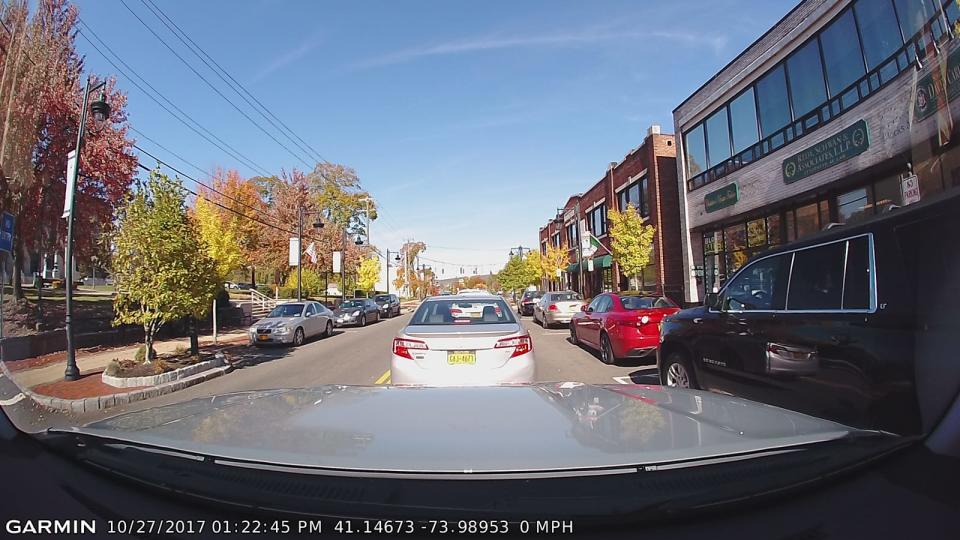
Size: Smaller is generally better, as larger units block more of your view of the road. But super tiny models may have cramped controls or a smaller display (or none at all).

Field of view (FOV): We preferred models with a FOV in the range of 140 to 160 degrees—that's wide enough to take in a wide highway or large intersection without creating a wide-angle effect that makes cars in front look further away and details harder to see.

Important for some people
Wi-Fi/smartphone app: We like an integrated Wi-Fi network because it lets the dash cam connect to compatible smartphone apps, which can let you view, download, or share video. Some show details like the vehicle's location and speed as well.
GPS receiver: A GPS receiver lets a dash cam record a car's location, trip history, and the speed and direction of travel—valuable info figuring out how an incident occurred. (It doesn't provide turn-by-turn directions; you need a dedicated car GPS navigator for that.)
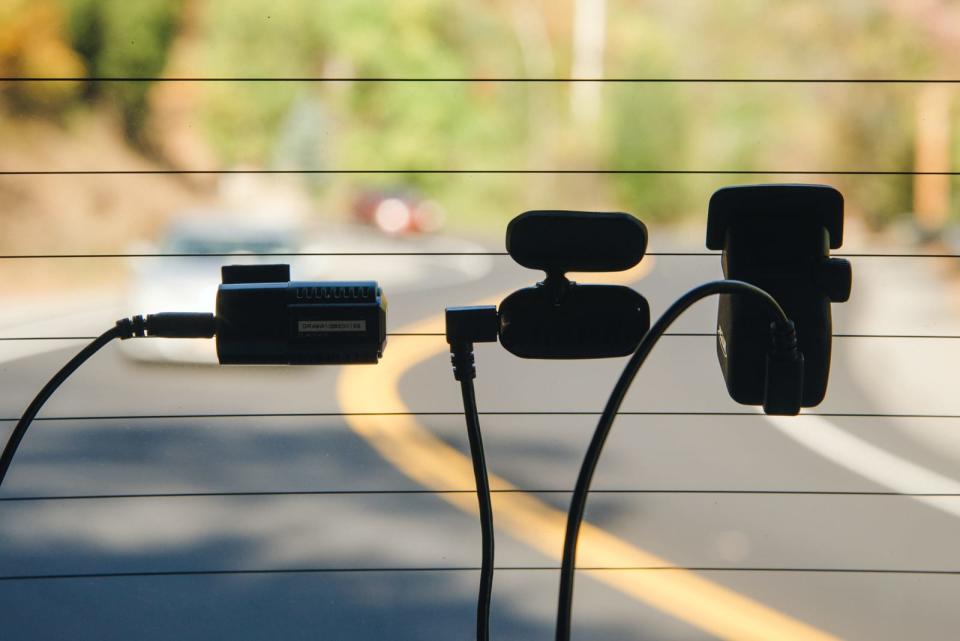
Dual cams: To record video of what's behind (or inside) your vehicle, as well as in front, a dual-cam model includes a second camera: either a small, separate camera that you mount to the car's rear window or a second lens that points toward the car's cabin and passengers.
Parking surveillance: Most dash cams' parking mode (which records impacts or movement around your parked car) are limited by their field of view or power supply. But some models designed to provide 24-hour security, such as the Owl Car Cam, do a better job of it.
Driver-assist features: Basic driver-assistance and safety alerts can include forward-collision warnings, which sound an alert if you are following too closely; lane-departure warnings, which let you know if your car is crossing a lane marker on the road; and other features that include stop-sign recognition, reminders to turn on your headlights, and driver fatigue reminders.
Capacitor power supply: Some dash cams use a capacitor for power (instead of a battery) which handles extreme temperatures better than the lithium-ion batteries. (So far, we haven't had temperature-related problems with dash cams during summer in Southern California.)
How we tested
We tested 18 single-cam, dual-cam, dual-cam/interior, and security models, evaluating the layout of the controls, the size and location of the buttons, and the ease of access. We checked the brightness and clarity of the display, navigated through the menus, and performed common tasks, taking notes on the build quality and overall design. We set up the dash cams in a test car, evaluating how easy it was to attach the mounts to the windshield, connect the dash cams to their mounts, adjust the aim of the camera, and then remove them. We tested them in bright sunlight and at night, and on highways and suburban streets, racking up hours of driving time. Then we spent hours examining the footage of each, stored on the microSD cards and on the smartphone apps. Finally, we made our picks.
Our pick: Garmin Dash Cam 55
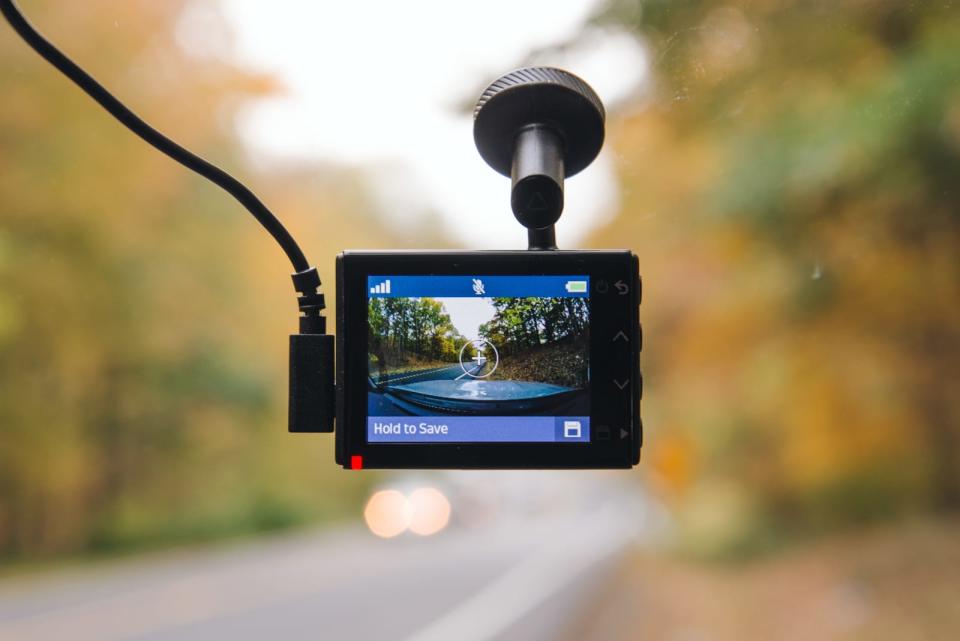
The Garmin Dash Cam 55 has a better image quality than most other models, and a compact, secure mount that's easy to adjust. It includes a built-in GPS receiver and Wi-Fi and uses voice control for common functions—a rare feature, and a welcome one, since the unit's physical controls are not the best.
Setting up the Garmin 55 is as easy as with most dash cams: Mount the unit on the windshield, plug it into the car's 12-volt outlet, and it starts recording when you turn on the car. It records to a microSD card, saving over the oldest footage (except for saved sections).
We found the 1440p resolution video to be sharp and clear, with good dynamic range. We could read strongly backlit license plates, plates of parked cars, and even some that were passing in the opposite lane—all tend to be a problem for many other dash cams. The 55's night video, another common problem area, showed clear detail in well-lit and shadowy areas.

Measuring only 2¼ by 1½ inches, the Garmin 55 is almost unnoticeable on the windshield. It attaches to a small magnet on the windshield held by a secure adhesive pad. A small ball joint gives it enough tension to keep the camera steady but allows it to be rotated freely. The magnet lets you easily pull the camera off the windshield, to adjust settings or stow it.
The location of the Garmin's physical buttons is not ideal, but the 55's voice control helps. With most dash cams, you need to press a button to save a section of video, start or stop audio recording, or take a still picture; with the 55, you say "OK, Garmin", and choose one of four options. The voice controls are responsive, but it's best to use the exact commands, and we've found the voice-recognition system can sometimes be activated by mistake by either in-car conversation or radio voices.
The 55's GPS receiver is integrated into the unit, so you don't need to find a location for a separate receiver, as you do with some competitive models. Also, an internal Wi-Fi network lets it connect with a (pretty basic) smartphone app—Garmin VIRB, at the App Store and also at Google Play—to download and share video and pictures.
Unlike most dash cams, the 55 has handy (but not essential) driver-assist features, including a forward-collision warning that beeps if following too closely, a lane-departure warning, and (with a paid subscription) red-light-camera warnings.
In a year of testing the nearly identical Garmin 65W (our previous upgrade pick), the footage and audio quality remain excellent, and the camera survived the heat of the Southern California summer.
Flaws but not dealbreakers
The 55's four small buttons are on the right side, far from the driver. Fortunately, their labels are next to the display, which helps when navigating menus, and the video-lock button is the lower one, which is easy to find by touch.
The 55 has a relatively narrow 122-degree field of view, so it could miss things happening on the periphery of your view.
We saw more glare in the Garmin's video than we did with the Nextbase models.
The Garmin has a small 2-inch display, which makes it a little harder to view videos than with most other models.
The 55 can monitor the car while it's parked with the engine off, but to use the feature, you must hard-wire an optional accessory cable to the car's electrical system. If this is a top priority, get the Owl Car Cam instead.
Garmin's VIRB app has mixed reviews. Complaints cite issues connecting to the app or saving and viewing video via the app. It doesn't show the car's location or driving parameters, unlike other apps.
The adhesive pad (for the magnet and mount) sticks to the windshield well but is hard to remove if you want to reposition it or use the Garmin in another vehicle.
Runner-up: Nextbase 512GW or Nextbase 612GW
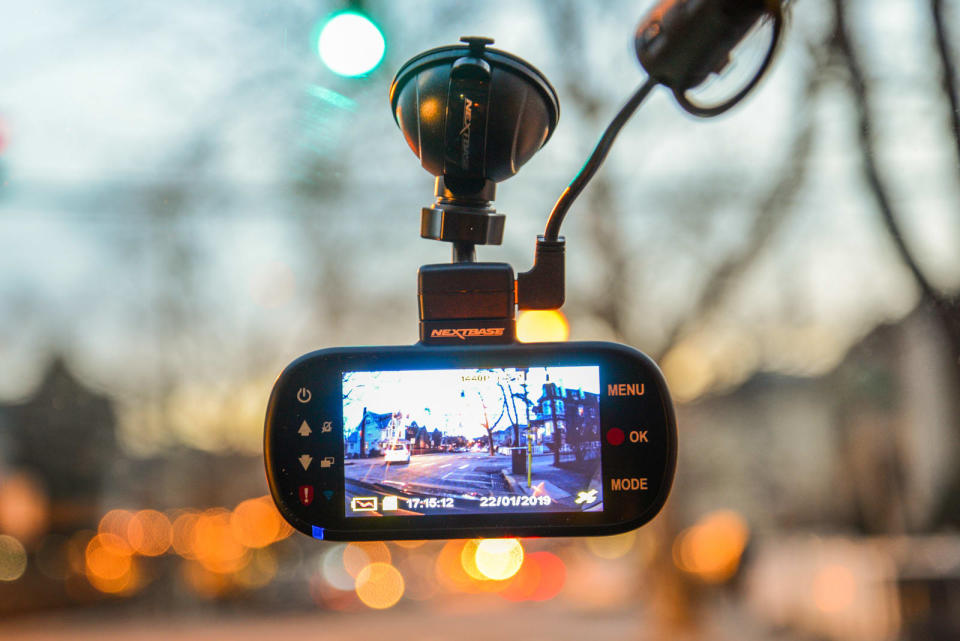
The Nextbase 512GW and Nextbase 612GW are two of the best dash cams we tested, with the sharpest images of any model we tested; the easiest-to-use controls; a thoughtfully designed mount that makes it easy to get the units on and off; bright, clear displays; the handiest smartphone app; and all the essential features. But these UK-developed products are new to the North American market and have been inconsistently available as of early 2019.
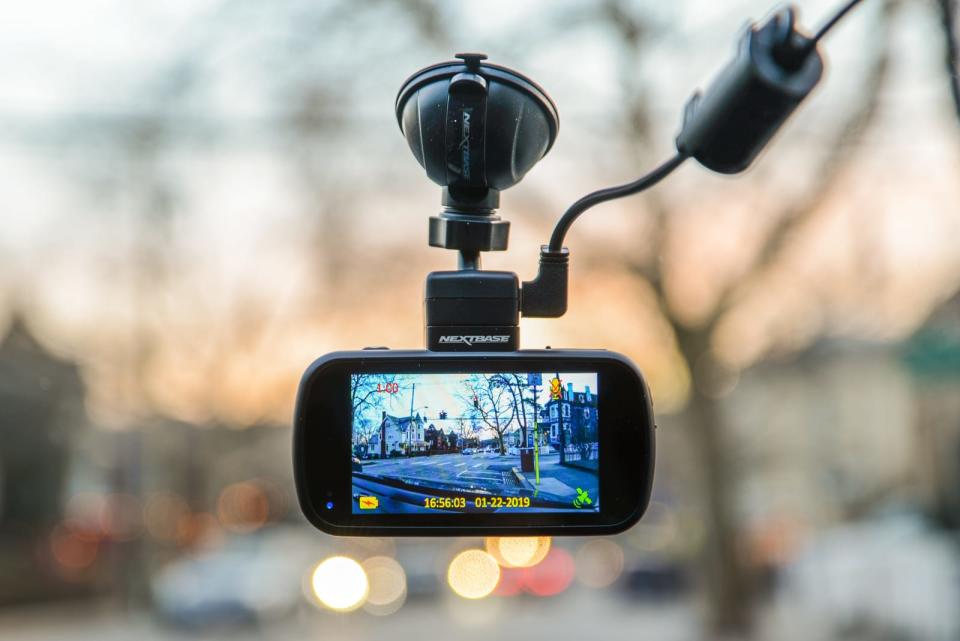
The 512GW records at a 1440p resolution, with a good 140-degree field of view, while the 612GW records at 2160p, or 4K, with a 150-degree FOV. The more-expensive 612GW's video is slightly sharper than the 512GW's, but the image quality of either is better than any other model we tested. The license plates of cars in front had crisper, clearer detail than we saw with other dash cams, and at slower speeds, we could easily read the license plates of parked cars or cars passing in the opposite lane. Videos captured at night were also impressive: good shadow detail, minimal glare, and easily legible license plates. Polarizing filters on the lenses, a unique feature, reduced glare from sunshine or headlights.
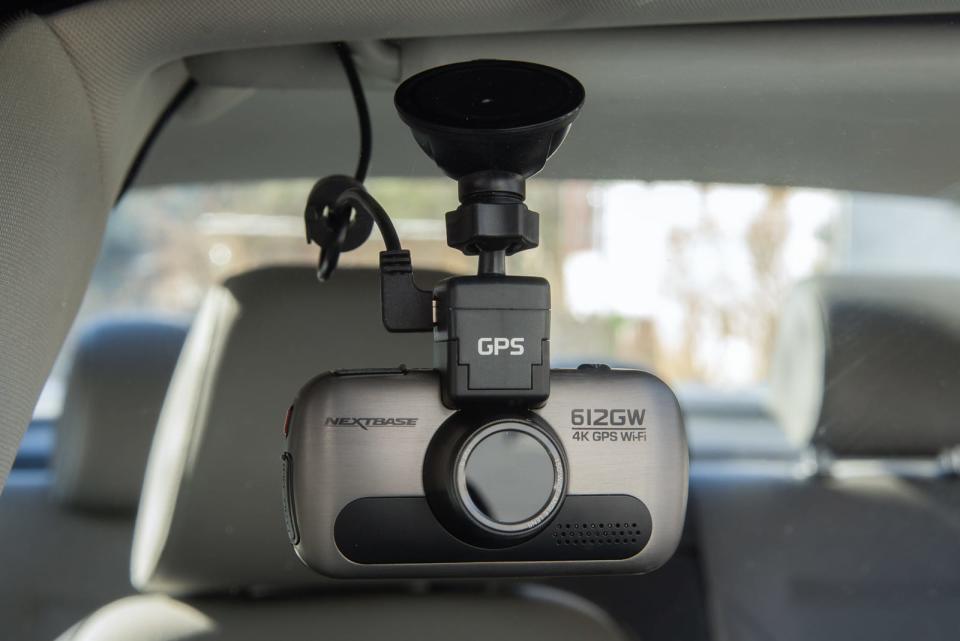
The Nextbase screens and controls are among the best we tested. Reviewing video and reading menus are easy on its large 3-inch display. An ambient light sensor dims the screen automatically in low light—a nice touch that we didn't see in any other models. Its seven buttons are large, clearly labeled, and easy to access, and the video-lock button is located on the lower left of the unit, closest to the driver, which works well if you need to save a section of video from being overwritten. Unlike most competitors, most of the 512's buttons are backlit for easier use at night. The 612GW (only) has a touchscreen, which works well.

Nextbase's suction mount attaches easily and holds the cameras securely. The power cord plugs into the mount, so you can simply slide the dash cam in and out of it, without having to attach or disconnect the cord. The GPS receiver is integrated into the mount, so, as with the Garmin 55, you don't need to find a location for a separate receiver.
An internal Wi-Fi network connects to Nextbase's app (available at both the App Store and Google Play) to view recorded videos, download video to a phone, or adjust settings. Unlike most other apps, you'll see the vehicle's location on a map, its speed, distance traveled, direction of travel, and the car's maximum and average speed. It also shows the car's g-force as it's driving, a unique feature that can prove how forceful an incident was. The app can generate a link for you to send video to an insurance company, attorney, or police.
The main shortcoming we've seen with the Nextbase models is inconsistent availability. Nextbase is the leading dash-cam manufacturer in the UK and a major brand in Europe, but it just entered the US in the past year and is available at few US retailers.
Budget pick: Papago GoSafe 550
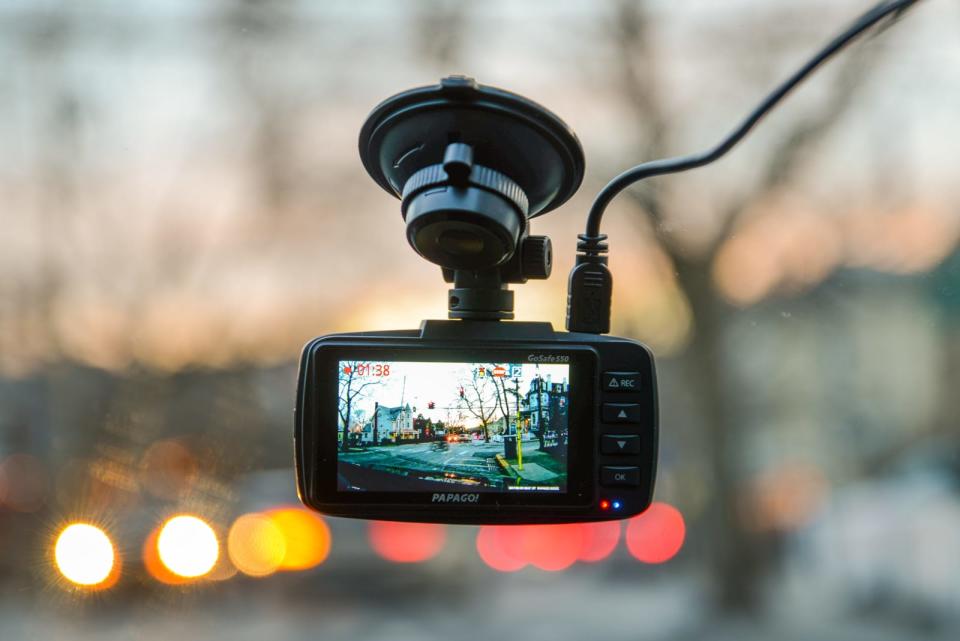
If you're looking to save a few bucks and are willing to settle for a more basic dash cam than the Garmin 55 and Nextbase 512GW and 612GW, get the Papago GoSafe 550. The 550's 1296p resolution delivers better image quality than many models, but it doesn't have the crispness of the Nextbase or Garmin. Also, its controls aren't as easy to operate, and it lacks a GPS sensor or Wi-Fi, so it can't connect to a smartphone app.
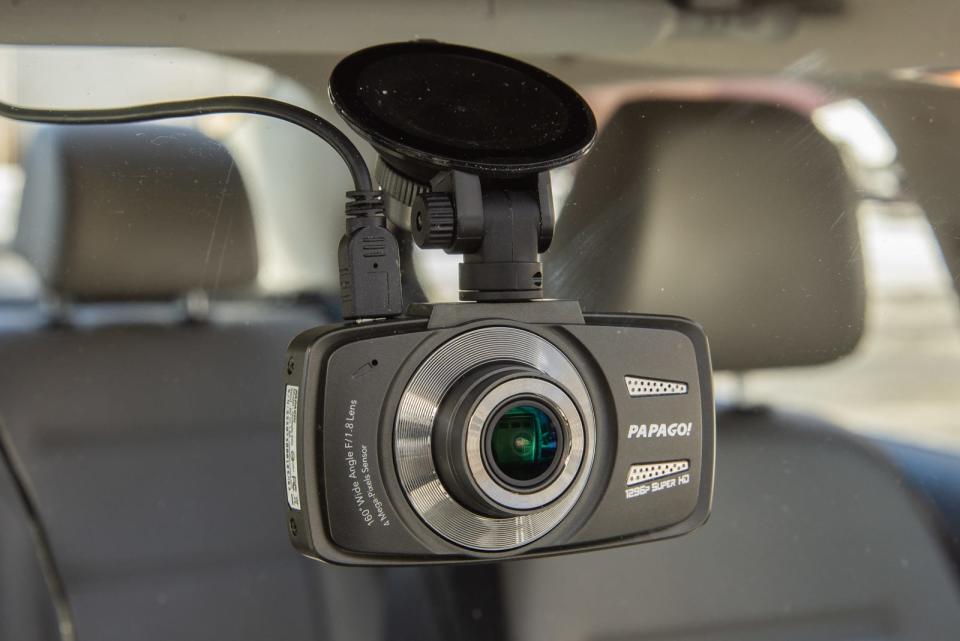
For its price, the 550 delivers good overall image quality, although the colors aren't as saturated as our other picks. At night, it provides good dynamic range and shadow detail, without a lot of glare. With a field of view of 160 degrees, the 550 takes in a slightly wider area than the Nextbase models and notably more than the 122-degree Garmin 55.
At about 3½ inches wide by 2 inches high, this Papago is about average size, and, like our other picks, it has a solid, well-constructed feel. It's also one of the more stylish models we tested. Its bright 2.7-inch display is about average for this category and larger than the Garmin 55's 2-inch screen. The four buttons on the back are easy to find by feel, but they're on the far right side of the unit, and the video-lock button is furthest away, in the top position.
The camera is easy to slide on and off of the suction mount but harder than others to adjust when mounted—to change the angle of the camera, you need to unscrew a small, knurled knob that can be difficult to grip.
The Papago includes driver-assist features like stop-sign recognition, delayed-start alert, a headlight reminder, and a driver-fatigue alarm. We used them all during testing, and the alerts weren't overly obtrusive.
The 550 monitors a parked vehicle in either a Motion Detection mode (which records video if it detects movement) or a Monitor Mode (which takes still pictures once per second)—but using either requires hard-wiring for continuous power. If this is a priority, the Owl Cam is a better choice.
Also great: Papago GoSafe S810

For a dual dash cam that can record behind your vehicle as well as in front, get the Papago GoSafe S810. As with other dual-cam models we tested, it records at 1080p resolution, which provides good detail, contrast, and decent dynamic range at night but isn't as sharp as our single-cam picks. Its field of view is a reasonable 140 degrees. The rear camera, compared to the front, produces usable footage, but it records at a more narrow 120-degree FOV and has a duller overall image with less sharpness and more contrast at night.
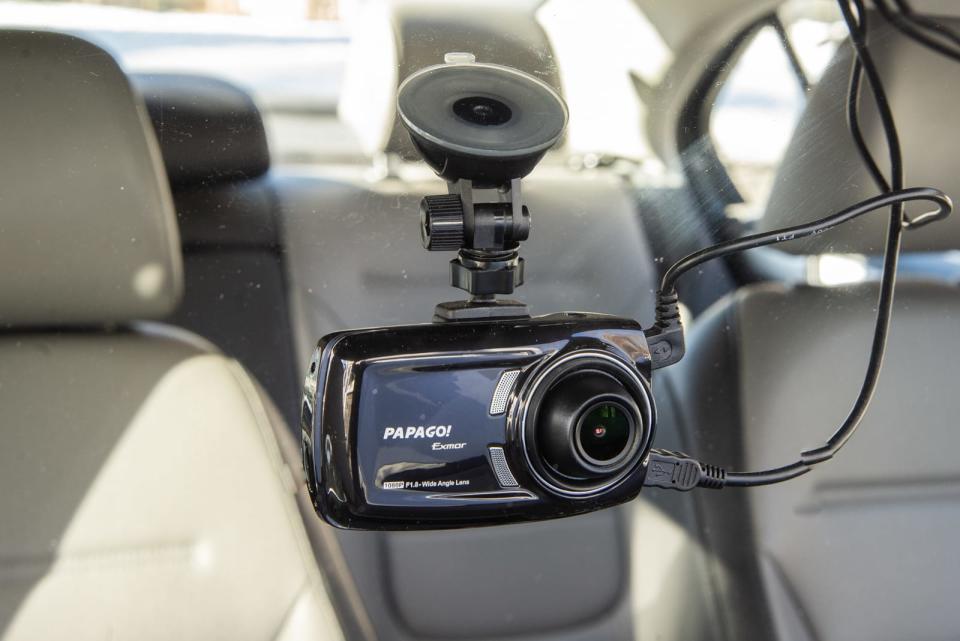
The S810 is similar to other dual-cam models in many ways: average size; bright and clear 2.4-inch screen; easily navigable menus; a versatile mount; and convenient video-lock button. The suction mount sticks well (an adhesive one is also included), and a large locking knob makes tightening easier in the mount than the Papago 550. The four buttons on its underside are hard to see at night, although they're easy to access by touch.
The S810 doesn't come with a GPS receiver, but you can connect an optional one if you want. And, like several of the dual-cam models we tested, it doesn't offer Wi-Fi or a compatible smartphone app. Like other Papago models, it includes a number of driver-assist features, including stop-sign recognition, departure-delay, a headlight reminder, and driver-fatigue alert.
Also great: Vantrue OnDash N2 Pro
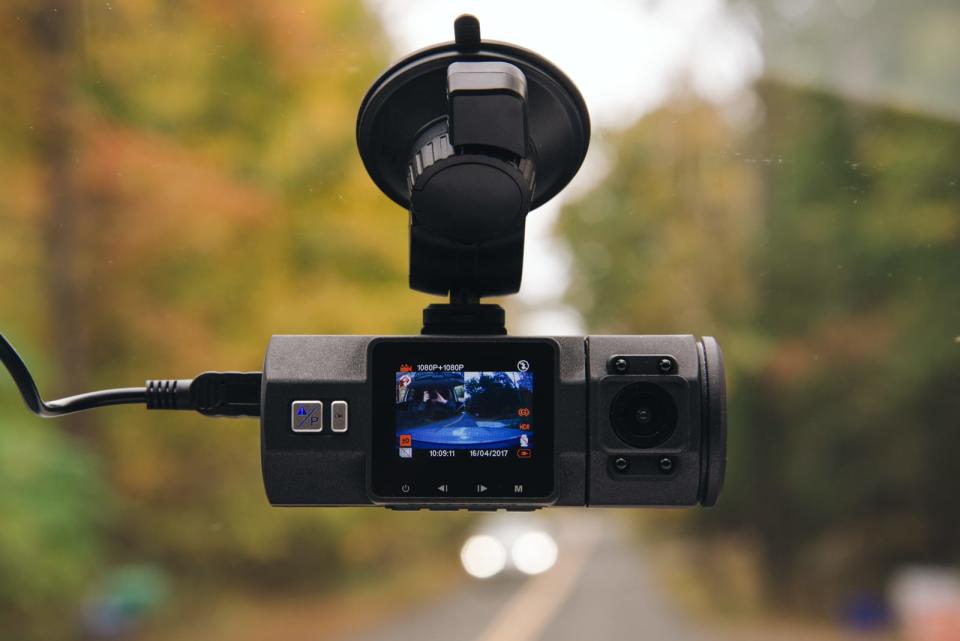
The Vantrue OnDash N2 Pro has two cameras: one pointed forward and the other aimed to the vehicle interior. The rear cam's 140-degree field of view lets you easily see people in the front and rear seats from door to door. But its road-facing image quality is weaker than our other picks, among other compromises, so we only recommend this if it's a priority to record passengers.
A key to the N2 Pro's superior performance are four infrared LEDs surrounding the rear camera lens that, when activated, let you see people in the vehicle even in total darkness. Without these LEDs, similar models captured totally black night video. The LEDs deliver a grayscale image, rather than a color one, but that's a minor nitpick.
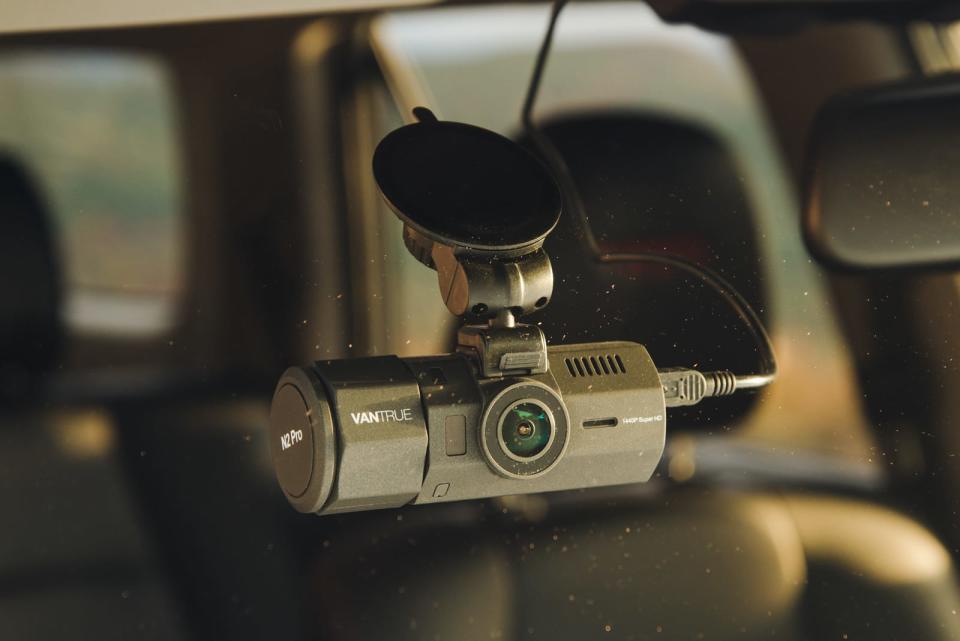
The OnDash N2 Pro's front camera records at 1080p resolution, which produces usable images with good color and contrast. At night, the video lacks sharpness and any glare can obscure license plates and other details. The front cam's 170-degree field of view is wider than our other picks, but it makes cars in front look further away. If you don't need the rear cam, the front camera can record at 1440p, like the Garmin 55.
The N2 Pro easily slips on and off its suction mount, which allows a wide range of adjustment for the front cam. The rear cam rotates vertically within the housing, but not side-to-side. This wasn't a problem in recording the area we wanted.
The N2 Pro's long angular shape doesn't draw attention to itself on the windshield, but its 1½-inch display was one of the smallest in our tests, and the unit's tiny buttons aren't as easy to use as those on our other picks.
Also great: Owl Car Cam
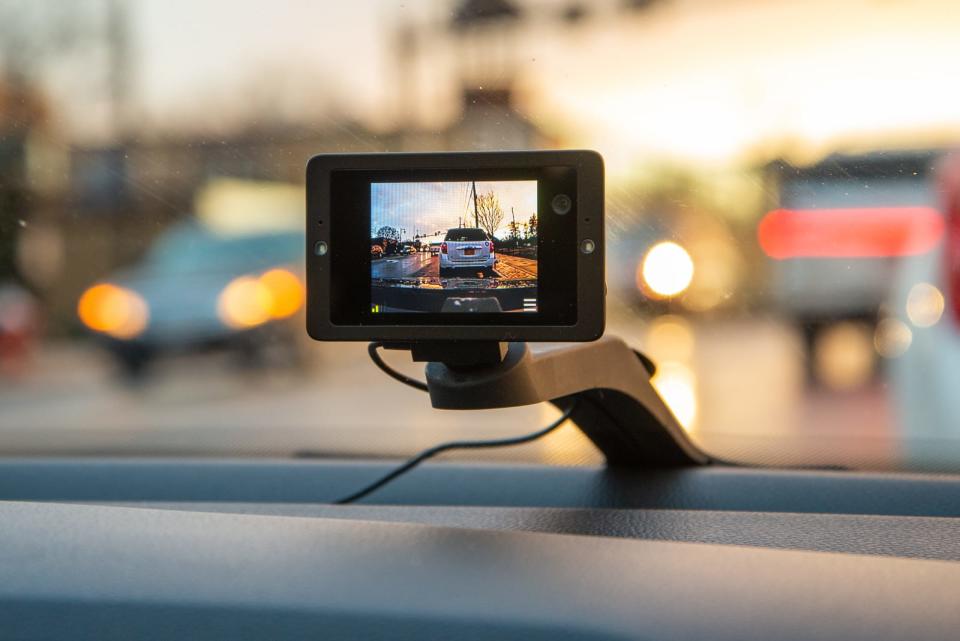
If it's important to you to have 24-hour surveillance of your car (whether it's parked or if someone else is driving it) get the Owl Car Cam. Through an app and LTE connection, the Owl can show live or recorded video, and it sends alerts if an incident occurs. But it's relatively expensive at the time of writing, and after a free first year, the LTE service costs $10 per month or $99 per year.
The Owl's two cameras record the front of the vehicle and the interior. If the Owl detects the sound of glass breaking, it illuminates the interior, begins recording, and uploads the video. If the device is stolen, you'll still be able to see the video (and the company will replace the unit free of charge with proof of the incident.)
The Owl Car Cam records in a sharp 1440p resolution in front and an adequate 720p in the rear. A large, clear 2.4-inch touchscreen displays the front-camera and rear-camera views simultaneously. The secure mount uses magnetic connections that snap together.
The Owl plugs into a vehicle's OBD-II diagnostic port (often under the dash close to the steering wheel) for continuous power. It can monitor the car and send alerts for up to 72 hours, and if it detects that the car's battery is getting low, it will go into a low-power standby mode.
To save a section of video while driving, you can either touch the screen or say "OK, Presto." You review video via the app—the Owl is unusual in that it doesn't record to a microSD card—and the company says unsaved video lasts for about 14 days before it's overwritten. The app also tracks your car's location on a map and can adjust the device's settings. Owl offers an optional 911 Assist service, in which agents contact you (or call 911) after a strong impact, but this costs $8 per month after the first three months.
What to look forward to
Several new dash-cam models were introduced at CES 2019 for launch this spring.
Nextbase introduced Series 2 dash-cam models, including the 322GW, 422GW, and 522GW. New features include Nextbase Emergency SOS, which help emergency responders locate your car following an accident if you're unresponsive. Amazon's Alexa capability will control these models' dash-cam functions through voice commands (starting and stopping recording, taking a picture, saving a recording) in addition to the normal Alexa functions. A new AutoSync feature will automatically send video files to a driver's smartphone following an incident, too.
Scosche introduced its Full HD Dash Cam, which works with the Nexar smartphone app and cloud service. It can record your drive and store relevant vehicular events to the cloud, so, following an incident, a detailed insurance report can be generated and submitted directly to participating insurance companies. It can also transmit and receive proximity warnings to nearby vehicles with compatible technology, allowing it to function as part of a larger vehicle-to-vehicle safety network.
The competition
Single-cam models
The Papago GoSafe 535, our previous top pick, has been discontinued. The newer Papago 550, our budget pick, is very similar and less expensive, although larger. Like the 550, the 535 provides a sharp 1296p maximum resolution and 160-degree FOV, as well as bright colors, good dynamic range, and decent contrast.
The Garmin Dash Cam 65W, our previous upgrade pick, is like the Garmin Dash Cam 55 plus two key differences. First, the 65W takes in a wider field of view (180 degrees versus 122 for the 55), which captures more of the scene in front of your car. But objects look further away, which makes it harder to see details. The 65W's 1080p resolution is not as sharp as the 55's 1440p.
Anker's Roav DashCam C1 Pro is a budget model with 1080p resolution and built-in Wi-Fi. But while its footage was fairly sharp and had good color, we saw a lot of video noise, and at night, a high level of contrast produced glare in lit areas and a lack of detail in darker ones.
The Rexing V1 3rd Generation records at 2160p (4K) resolution, but its 24 frames per second isn't as smooth as the usual 30 fps, and with muted colors and excessive glare, it wasn't as crisp as the Nextbase 512GW's 1440p image. In night video, the footage was contrasty and grainy. We also found it hard to adjust the lens position or connect the app.
The Vantrue OnDash X3's 1440p video isn't as crisp as the 1440p Nextbase 512GW, and its night video has a lot of contrast. The buttons on the rear are easy to access, but their labeling is difficult to read. The power cord connects directly to the mount, but the camera doesn't slide in and out of the mount smoothly. The app is basic, and we had trouble connecting it to the X3.
The GEKO S200 Starlit wasn't as sharp as you'd expect from its 1296p resolution. This compact unit has a cheap plasticky feel, with small buttons that tend to wiggle when pressed, and a black-on-black design with minimal labeling that's hard to read at a glance. The S200 lacks GPS, Wi-Fi, and a smartphone app.
The Vantrue T2 monitors a vehicle while it's parked, but for normal use, we found its 1080p video to be noticeably less sharp than that of our picks, with small, poorly labeled buttons that were hard to use. And the T2 doesn't provide GPS or Wi-Fi. It is one of the few single-cam models we tested that uses a capacitor instead of a lithium-ion battery.
The Thinkware X350 has has worse video quality than our picks, and its optional plug-in GPS receiver is less convenient. It uses a capacitor instead of a lithium-ion battery.
The Rexing V1N, one of the least expensive dash cams we tested, has a 1080p max resolution and a wide, 170-degree field of view. In our tests, the V1N's video was not as good as that of the picks, with too much contrast, especially at night.
The inexpensive Papago GoSafe 228 had the worst image quality of any model we've tested and a fairly narrow 120-degree field of view.
Dual-cam models
The BlackVue DR900S-2CH has a super-high 2160 (4K) resolution that delivers excellent sharpness and wide dynamic range. Both the front and rear cameras shoot excellent night video, but both show more glare than the Nextbase models. The unit has no display and minimal physical controls, so all settings—even camera alignment—require an app, which had connection issues in our tests.
The BlackVue DR490L-2CH is one of the better dual-camera models we tested, and its 3.5-inch touchscreen, with large on-screen buttons, is easy to operate. The dealbreaker: there's no video-lock button to manually save footage. The mount also has no side-to-side adjustment, which limits where the camera can be positioned.
The video quality of the Rexing V1P 3rd Generation was average, with contrast and excessive glare. Its buttons illuminate when pressed, but without touching one, they're invisible at night. The lens can be adjusted in any direction by physically moving it, but this is difficult when the unit is mounted on the windshield.
Designed to record a vehicle's interior, the Rexing V2's night interior video is almost totally black without ambient light. The cameras rotate about 180 degrees vertically, but not side to side, so it's hard to get both aligned properly. The V2 is about 5 inches wide by 3½ inches high, which takes up a lot of real estate on the windshield.
The Papago GoSafe S780's rear camera mounts on the rear window (to record behind the car), or on the windshield (to record the interior). But it's needlessly expensive, the rear camera is so-so, and if there's no ambient light, the interior image is almost totally black. We had a difficult time tightening the mount's plastic locking nut without it going on crooked.
The Papago GoSafe 760 doesn't stand out against its competitors, with weaker video, especially at night, from the 1080p front and the rear cameras. The rear camera has a narrow 120-degree field of view, and at night, lacks detail in darker areas, with a glare that makes license plates hard to read.
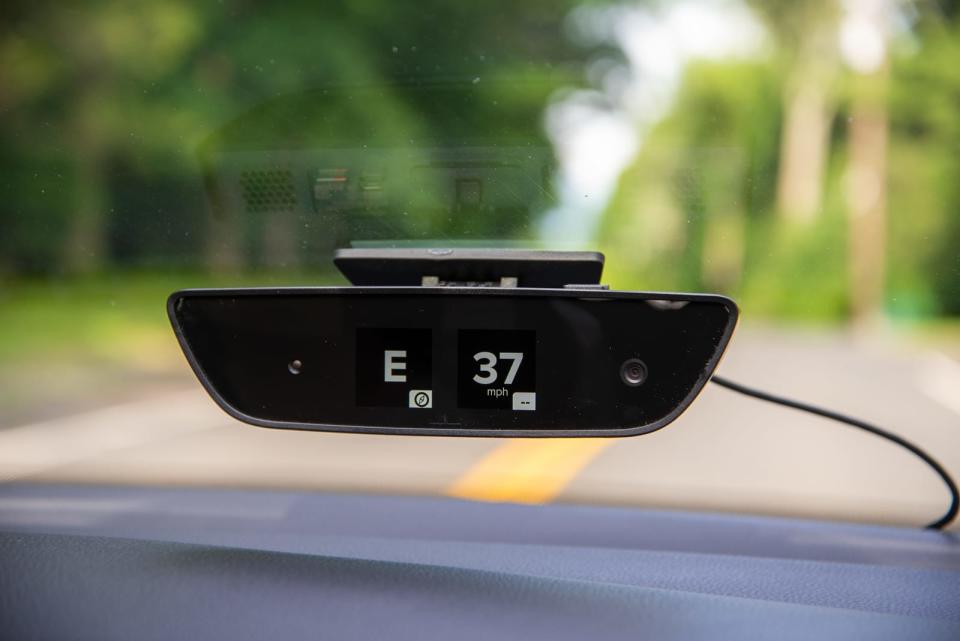
The BlackVue DR490-2CH lacks a display, which saves space, but without Wi-Fi or a smartphone app, you must play all footage back on a computer (preferably in BlackVue's video player). The front and rear cams provided good contrast and dynamic range, and its capacitor power supply adds reliability in extreme temperatures.
The Transcend DrivePro 520 can record a car's interior, but the rear camera has a very narrow, 110-degree field of view, and seeing people at night in the rear seat was harder than with the VanTrue OnDash N2 Pro.
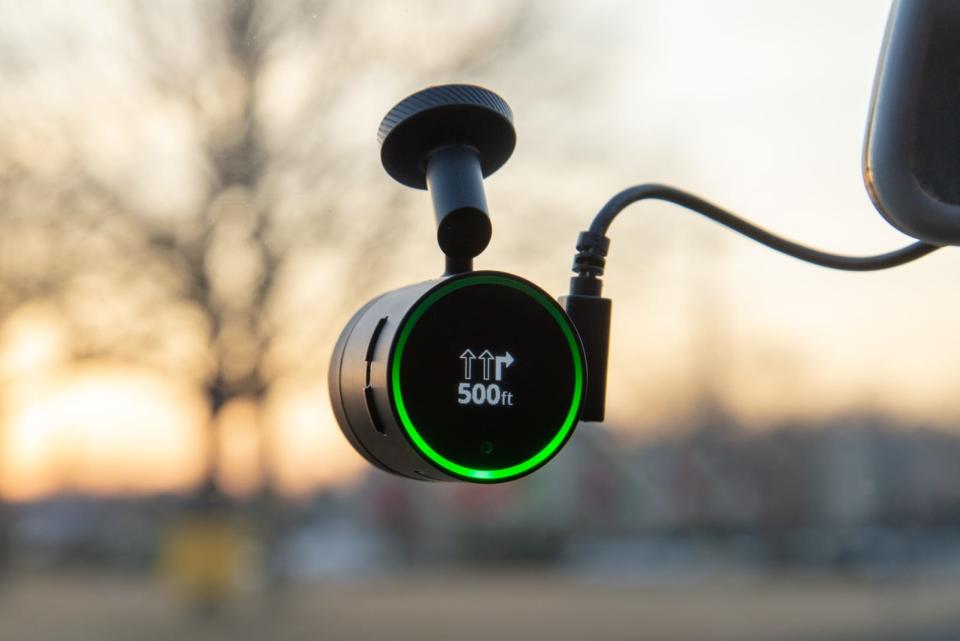
Multifunction models:
The Garmin DriveAssist 51 LMT-S, our upgrade pick in our car GPS guide, is a GPS navigator with a built-in dash cam, but its video isn't impressive. Still, if you primarily want a GPS navigator and don't need the razor-sharp video of the Garmin 55 and Nextbase models, you can probably get by with this and skip the separate dash cam.
The Garmin Speak Plus is a unique voice-activated device that includes a 1080p dash cam, Garmin navigation, and Amazon's Alexa capability. It's effective for navigation, but if you primarily want a dash cam, there are better choices. It has a very narrow 82-degree field of view, the compact display does not show dash cam video, and the unit needs to be paired to your phone via Bluetooth to function at all.
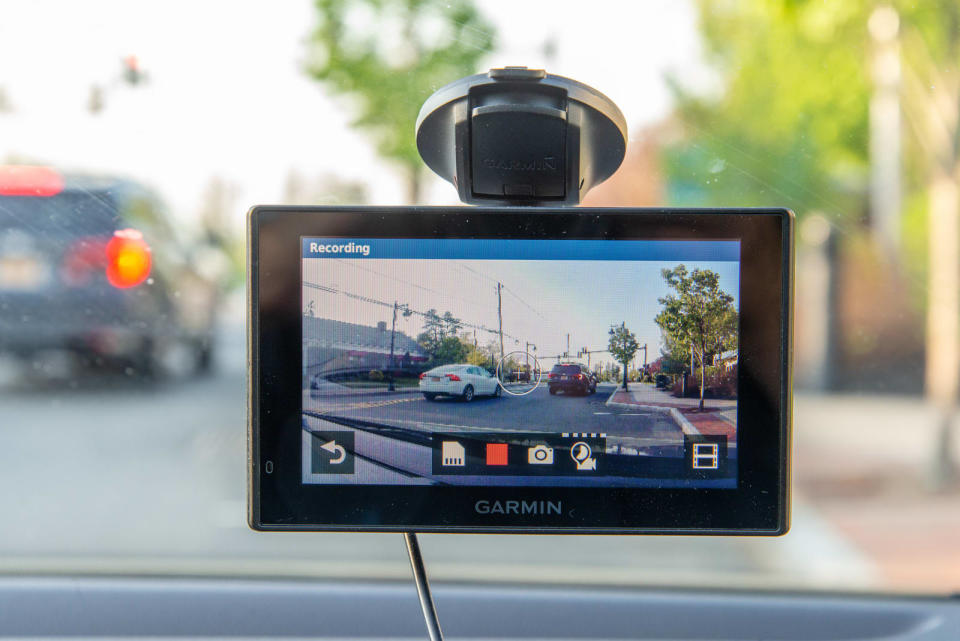
The Waylens Secure360 monitors a parked vehicle, and like the Owl Cam, its LTE connection saves video of incidents (or shows live video) on its app. (The Wi-Fi version records to a microSD card.) Its 360-degree lens records in front of the car and the interior, but details are hard to see. It also lacks a display, needs to be hard-wired into a car's fuse box for continuous power, and requires purchasing a data plan.
The Klashwerks Raven combines a dual-cam setup with navigation, security, and vehicle tracking, but it's hard to get both cameras aligned and difficult to consistently save video using its gesture controls. In hot weather, the adhesive mount had trouble holding the large 7-inch device on the windshield. We tested an early unit (in the summer of 2018), and Klashwerks has released a number of updates since our test, so we may take another look at it in the future.
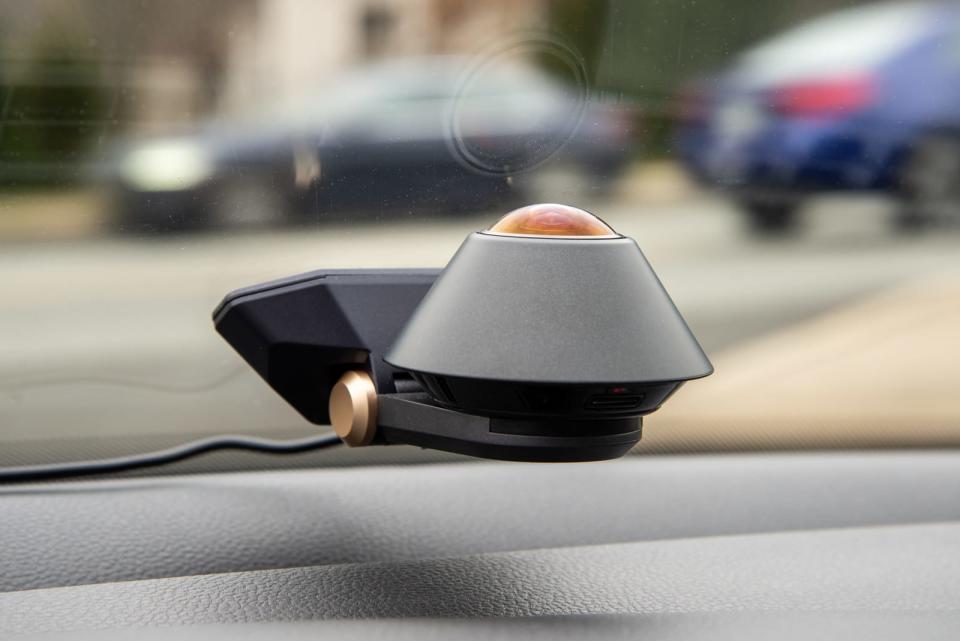
How to set up a dash cam
For the best view of the road ahead, mount a dash cam high in the center of the windshield, near the rearview mirror. You want to see the unit's screen and easily reach its controls while minimizing how much it blocks your forward view. Some states have regulations about what can be mounted on a windshield and where, so check your local laws.
Most dash cams have a long cord that plugs into a car's 12 V DC outlet (also known as cigarette lighter). To get the dangling cord out of your way, we suggest running it to the passenger side and tucking it into the molding between the top of the windshield and the car's headliner. From there, you can run it down along the edge of the windshield and the front pillar, into the gap on the side of the dash, and underneath the dash to the power outlet. It's not hard, but it can require patience to get it secured. Some models include small cable-holding clips that adhere to the glass and hold the cord. This video does a decent job of showing how to perform a tidy installation.
If your interior is short on USB outlets and you can't give up your only 12 V connection for this camera, you could also consider using a USB car charger and a longer USB cable or a 12-volt splitter; we had success with these 3-outlet splitters in our testing.
This guide may have been updated by Wirecutter. To see the current recommendation, please go here.
When readers choose to buy Wirecutter's independently chosen editorial picks, Wirecutter and Engadget may earn affiliate commissions.
